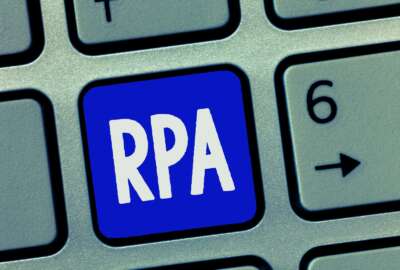

Hubbard Radio Washington DC, LLC. All rights reserved. This website is not intended for users located within the European Economic Area.
George Mason University has teamed up with robotic process automation vendor UI Path to give a push to governmental use of RPA.
Best listening experience is on Chrome, Firefox or Safari. Subscribe to Federal Drive’s daily audio interviews on Apple Podcasts or PodcastOne.
In their tries at becoming more efficient, a growing number of federal agencies are turning to robotic process automation, or RPA. It’s a method for having computers do repetitive or low-value tasks, instead of people. Now George Mason University has teamed up with RPA vendor UI Path to give a push to governmental use of robotic process automation. For more, the Federal Drive turned to the director of the Center for Business Civic Engagement at George Mason University, Dr. David Rehr.
Interview transcript:
Tom Temin: Dr. Rehr, good to have you on.
Dr. David Rehr: Thanks for having me.
Tom Temin: Tell us a little bit about the Center.
Dr. David Rehr: The Center’s focus, historically, for about the last three and a half years, has been bringing more efficiency and effectiveness to government. We all hear the stories, we pay a lot in our taxes, and we want to be sure we’re getting our value. So we have focused on transparency, accountability, stewardship, and now we’ve moved to using technology as a way to drive more effective and more efficient speed through robotics process automation.
Tom Temin: And what gives you the sense that there’s a desire for this in federal agencies. We hear it all the time also..
Dr. David Rehr: Well, I think it’s two things, I think, one, there are constant constraints on federal spending, and people have to try to get more with less. And you can add technology, and you literally can get more with less. And I think the second thing is that the stewards, the taxpayers, the citizens, want to make sure they’re getting serviced, and they’re getting their value. So no one wants their time to be wasted. And they want to be sure that when they fill out forms or when they’re conducting business, it’s done as efficiently with their time as possible.
Tom Temin: And just briefly, I gave one definition of RPA, let’s hear your definition, and how it’s applied to say a customer or citizen facing service, RPA could help government agencies appear more efficient to the constituents and really be more efficient.
Dr. David Rehr: Well, I would break it down into three things. One is it allows the agency, the department, to look at their processes and make sure they’re appropriate and still timely. We’ve got the GAO being one of the leaders in RPA, actually, the guy who runs the program there said that he was really excited by the number of things they no longer had to do because RPA brought in the technology that allowed them to get the data and get the information without going through a lot of the prior processes. I think secondly, it allows people to kind of think more clearly about what their focus is. One of the issues with government is because it’s based in politics, and Washington is so partisan now that they get pulled in thousands of different directions, trying to be the boss to hundreds of masters, 535 plus the administration to be exact. And I think RPA helps them stay focused and logical on what they’re trying to accomplish. And then thirdly, and most importantly, it really allows people to see results. Sometimes we don’t know what’s going on inside federal agencies and departments, but I think with RPA, and the technology and coupling that with AI, artificial intelligence, you can actually like have printouts of how many people you served, what the results were, what the hang ups were. Which then allows people to say, how do we make these programs even more effective?
Tom Temin: And if you are an agency mission owner or Deputy Secretary, whatever the case might be, someone in leadership or managerial position, how do you go about the process of deciding what you want to robotically automate so that you will get some return on the investment?
Dr. David Rehr: Right, good question. I think you do a couple of things. Number one, there are about 20 federal agencies and departments now they’re using some element of RPA. And they just produced report this last year on kind of the state of RPA in the federal government. And I would say, go get the report, go there first, see what your colleagues are using, and then think about how it might apply for yourself. There’s a lot of things that agencies and departments do that are very similar that one is probably doing now with a robot, and they could actually, not steal it, but pick what works for them and then apply it to their agency or department. I think secondly, be more attuned to kind of the technology, you don’t have to be an expert on it., we’re not at George Mason. But part of our mission with this RPA initiative is to make it more generally recognized, more public, more research turned out. And we really want to help agencies and people inside all levels of government, at the federal, state and local level understand the potential and how it can apply to them.
Tom Temin: And you do have this agreement and a kind of teaming arrangement with this company, UiPath. Tell us what that’s all about and how it works.
Dr. David Rehr: Well when we first decided to look into this field, UiPath is one of the industry leaders in robotic process automation, and really have set the gold standard on what needs to be done. And I met with their people, we talked about what we wanted to do. And one of the things that I learned from the conversation is, if you know about RPA, you know about RPA. But if you don’t, you’re like living on another planet. We all have so many things going on, that it might miss you, you might not learn about it. I was not aware of the problem until the COVID pandemic really hit us and start learning about all the things that UiPath and the other companies were doing to help solve the pandemic problem. And it kind of amazed me, and I thought, it’s very strong in the business community, they’re using it very aggressively. And I thought, we should probably have the government use this more because it will help solve problems. And it will help solve problems at minimal costs, and will help people inside government not to get bored or get worried by the mundane things in their jobs, but stay focused on strategy and what needs to be done to actually solve problems, and not just kind of talk about them forever.
Tom Temin: And with respect to the Center for Business Civic Engagement, how do the learnings that you create, say, with a company like this or other partners, how do they get transferred to government practitioners?
Dr. David Rehr: Right. Well, I think we’ll have more partners. UiPath was kind of the first lead on this, and we’re very open to having more people involved. Since our announcement, we’ve had a very positive reaction from people in the RPA community. Secondly, I think we actually do this at George Mason through research, through speeches, through webinars. We make it open to the public because George Mason has really a great reputation on being innovative, and being focused on technology. We’re based in Northern Virginia, which is a technology hub. And I think people will want to learn more about this. And the powerful influence of social media, and media in general, even radio, like your show and others, will kind of help educate people that were there. And it’s all free. And it’s all available. And we’re destined to use it to have people learn.
Tom Temin: And do you have any examples early on of RPA, in this case, having success in an agency?
Dr. David Rehr: Yeah, actually, there are several. There is a prominent GAO survey that came out and I heard one of the heads of the GAO speak about it. And he said it saved thousands of business hours that they could now use those individuals on higher profile things. Secondly, he said that there were lots of processes that they found out they no longer needed, because they could get the data information. Certainly, there’s a lot of COVID activity going on where RPA is being used to make sure that hospitals that need Medicaid reimbursement, we can do this quickly. COVID lines to get tests can be reduced from hours literally to minutes by using technology, you don’t have to fill out the paperwork anymore, etc. And we recently had example of California and the Department of Motor Vehicles, where people needed their license extended, and the state couldn’t meet with them because of COVID restrictions, but they were able to develop an RPA solution, which has saved something like $2 million and allowed the citizens of California more access to get their driver’s license extended.
Tom Temin: It sounds like then that the decision to deploy RPA doesn’t start with the IT people in an agency, but really with the people delivering service.
Dr. David Rehr: Right, right. Well, it’s really an all agency effort. And I think a lot of it has to be the IT people have to be comfortable with the transition. The people who are in the agency have to think how can we provide better service, which they’re constantly thinking about, but sometimes are constrained by spending or priorities. And I think it really liberates people to use their imagination and to use their value to do more for people with the same amount of money or less.
Tom Temin: Dr. David Rehr is director of the Center for Business Civic Engagement at George Mason University. Thanks so much for joining me.
Dr. David Rehr: Well, thank you for having me.
Copyright © 2024 Federal News Network. All rights reserved. This website is not intended for users located within the European Economic Area.
Tom Temin is host of the Federal Drive and has been providing insight on federal technology and management issues for more than 30 years.
Follow @tteminWFED



